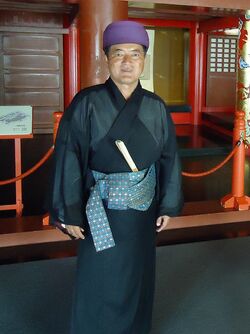The colors and types of materials worn by aristocrats indicated their rank. This was seen especially in the colors of the hachimaki (court cap or turban) and court robes, and in the material (gold or silver) used to make hairpins. A summary of the significance of colors in the court costume of male officials is included in the description of Ryukyuan court ranks.
Medieval Ryukyu
During the First Shô Dynasty, Ryukyuan court costume is believed to have closely resembled the Chinese chángshān, a long shirt that wrapped around the body. Officials wore white, black, or red robes depending on their rank; all had embroidered designs along the openings of the sleeves and of the neck. Hachimachi court caps and hairpins also indicated rank.[1]
Both during the First Shô Dynasty and throughout the early modern period, members of the royal family, Kumemura elites, and certain others wore court costume in the style of the Ming Dynasty on certain special occasions, including when traveling overseas on diplomatic embassies.[1]
Early Modern Ryukyu
While the royal and aristocratic classes are today strongly associated with the colorful bingata, traditionally they would have worn bingata robes only when going out of the palace; in the private areas of the castle, members of the royal family were more likely to wear a simpler outfit of a red dujin wrap-shirt and white kakan skirt, throwing a bingata robe over this when going out.[2] Bingata was not generally worn for major court ceremonies, and further it was typically only worn by adult women and by young people (both male and female); adult men typically only wore bingata as a costume for dance or theater.[3]
By contrast, the typical men's garment worn during official duties was a simple black robe, cinched at the waist. Known as kuruchô (黒朝, lit. "black court [robes]"), it was often made of extremely fine bashôfu fibers, woven so finely as to have a texture similar to silk.[4]
The colors of women's garments were also significant, indicating the rank of their husband or family. The queen and royal princesses wore goldish yellow silk or satin damask, a color long considered an Imperial color in China, while wives of anji or ueekata wore kasuri (ikat) fabrics, especially tsumugi, in green or pale blue (or yellow, for higher-ranking anji families). Pink kasuri garments indicated wives of those of peechin or satunushi status, while the wives of the chikudun, the lowest-ranking nobles, wore blue kasuri. The highest ranking noblewomen wore gold hairpins, while other noblewomen wore silver; commoners wore hairpins made of copper, brass, bronze, wood, or other materials. Deep blue garments dyed with indigo were standard among the commoner/peasant class; these were made of various materials, including bashôfu and cotton, but excluding ramie (jôfu), which was off-limits for commoners. Kasuri garments were worn by members of all classes, from the royalty down to the peasantry,[5] but particularly large kasuri patterns were limited to the aristocracy.[6]
References
- ↑ 1.0 1.1 Uezato Takashi, Dare mo mita koto no nai Ryukyu, Naha: Borderink (2008), 28.
- ↑ Okinawan traditional clothing demonstration, East-West Center International Conference in Okinawa, Sept 2014.
- ↑ Bingata! Only in Okinawa, 91, 112.
- ↑ Bingata! Only in Okinawa, 112.
- ↑ Gallery labels, Naha City Museum of History, August 2013.
- ↑ Bingata! Only in Okinawa, 108.
